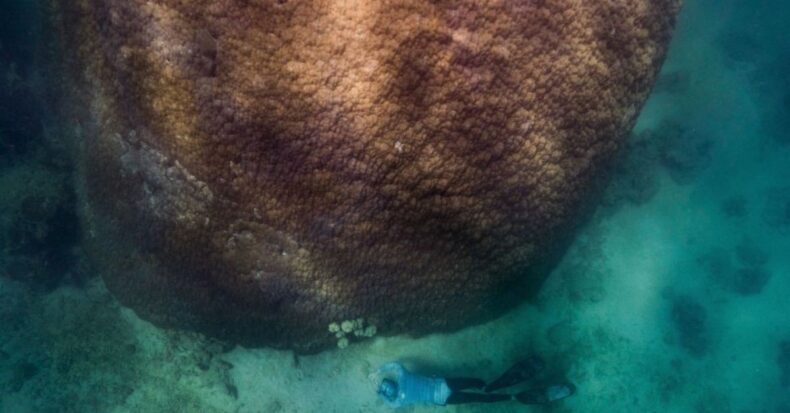Australian scientists have discovered one of Earth’s most extensive coral reef system’s largest and oldest coral colonies in the Great Barrier Reef.
Snorkelers find record-breaking coral off the coast of Goolboodi, part of the Palm Island Group in Queensland, Australia.
The massive coral measures 34 feet (10.4 meters) wide and 17.4 feet (5.3 m) tall, making it the most expansive and sixth-tallest coral in the Great Barrier Reef.
They named it “Muga dhambi” — meaning “big coral” in the language of the Manbarra people, who are the Indigenous people of Palm Islands.
“The structure is probably one of the oldest on the Great Barrier Reef,” Nathan Cook, a marine scientist at Reef Ecologic, an NGO in Australia specializing in corals, told Live Science.
Muga dhambi has described this week in the journal Scientific Reports with co-authors that included 17-year-old Kailash Cook, who helped measure the coral during the dive, and the “godfather of coral”, 76-year-old Dr Charlie Veron, who helped identify it.
Lived long before European exploration

Muga dhambi is a marine habitat that is relatively distant, infrequently visited, and well-protected. It was discovered in March of this year during a citizen science study on a reef slope not far from the beach.
We measured the structure at 5.3 meters tall and 10.4 meters wide.
This makes it 2.4 meters wider than the broadest Great Barrier Reef coral previously measured by scientists.
Muga dhambi is of the coral genus Porites and is a large group of corals known as “massive Porites”. It’s brown to cream in color and made of small, stony polyps.
Muga dhambi belongs to the genus Porites and is part of the “huge Porites” group of corals. It’s made up of small, rocky polyps and is brown to cream in color.
As they mature, these polyps secrete layers of calcium carbonate beneath their bodies, which serve as the foundations for reefs.
Muga dhambi’s height indicates that it is between 421 and 438 years old, indicating that it lived long before European exploration and colonization of Australia.
Rock coral growth rates and annual sea surface temperatures were used to make this calculation.
The Australian Institute of Marine Science has investigated more than 328 colonies of massive Porites corals along the Great Barrier Reef and has aged the oldest at 436 years.
The institute has not investigated the age of Muga dhambi. However, the structure is probably one of the oldest on the reef.
Other comparatively large massive Porite colonies have previously been found throughout the Pacific.
Resilient but vulnerable

Muga dhambi has survived up to 80 significant cyclones, numerous coral bleaching events, and centuries of exposure to invasive species, low tides, and human activity.
The Conversation reviewed environmental events over the past 450 years and found it is unusually resilient.
About 70 percent of its body consisted of live coral, but the remaining 30 percent was dead. The top of the structure was covered with a dull green sponge, turf algae, and green algae.
Coral tissue can die from exposure to the sun at low tides or warm water. Dead coral can be quickly colonized by opportunistic, fast-growing organisms, as is the case with Muga dhambi.
Researchers found marine debris at the base of Muga dhambi, which is a threat to the marine environment and species such as corals.
The sponge’s advances will likely continue to compromise the structure’s size and health, they say.
As such, no evidence of disease or coral bleaching has been found.
A wonder for all generations
No database exists for significant corals in Australia or globally. Cataloguing the location of massive and long-lived corals can be beneficial.
Diving tourism can have several social and economic benefits according to scientist reseaarch. For example, it can be used to understand climate models and social and environmental benefits.
However, the location of massive corals could lead to them being damaged by anchoring, research, and pollution from visiting boats.
Climate change, declining water quality, overfishing, and coastal development are all posing severe threats to all corals in the Great Barrier Reef in the future.
We recommend keeping an eye on Muga dhambi in case it needs to be restored in the future.
For more details click here













